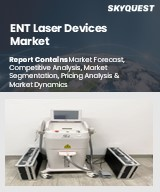
|
시장보고서
상품코드
1789225
이비인후과용 레이저 기기 시장 규모, 점유율, 성장 분석 : 용도별, 유형별, 최종사용자별, 지역별 - 산업 예측(2025-2032년)ENT Laser Devices Market Size, Share, and Growth Analysis, By Application (Throat & Mouth Cancer, Transoral Laser Microsurgery), By Type (Gas Laser, Solid Semiconductor Based Laser), By End User, By Region - Industry Forecast 2025-2032 |
||||||
세계의 이비인후과용 레이저 기기 시장 규모는 2023년에 1억 2,000만 달러로 평가되며, 2024년 1억 2,810만 달러에서 2032년에는 2억 1,690만 달러로 성장하며, 예측 기간(2025-2032년)의 CAGR은 6.8%로 성장할 전망입니다.
부비동염, 편도선염, 자궁경부암 등 이비인후과 질환의 발병률 증가로 인해 이비인후과용 레이저 장비 세계 시장은 임상의들이 레이저 기술의 정확성과 저침습성의 장점으로 인해 레이저 기술을 선호하고 있습니다. 이러한 질환의 빈도가 증가함에 따라 병원과 전문 클리닉은 기체 레이저와 고체 레이저를 모두 채택하여 수술 정확도를 높이고 수술 시간을 단축하는 경구용 레이저 현미경 수술이 용이해졌습니다. 주요 시장 동향으로는 레이저 기술의 급속한 발전, 특히 다이오드 레이저와 파이버 레이저는 빔의 안정성을 향상시키고 실시간 이미징 시스템과의 통합을 가능하게 하는 등 레이저 기술의 급속한 발전이 있습니다. 북미는 막대한 헬스케어 지출과 첨단인 임상 인프라를 바탕으로 도입을 주도하고 있으며, 유럽이 그 뒤를 바짝 뒤쫓고 있고, 아시아태평양은 헬스케어 투자 증가와 혁신적인 이비인후과 치료에 대한 인식으로 상당한 성장 잠재력을 보여주고 있습니다.
목차
서론
- 조사의 목적
- 조사 범위
- 정의
조사 방법
- 정보 조달
- 2차와 1차 데이터 방법
- 시장 규모 예측
- 시장의 전제조건과 제한
개요
- 세계 시장 전망
- 공급과 수요 동향 분석
- 부문별 기회 분석
시장 역학과 전망
- 시장 개요
- 시장 규모
- 시장 역학
- 촉진요인과 기회
- 억제요인과 과제
- Porter의 산업 분석
주요 시장 인사이트
- 주요 성공 요인
- 경쟁의 정도
- 주요 투자 기회
- 시장 에코시스템
- 시장의 매력 지수(2024년)
- PESTEL 분석
- 거시경제 지표
- 밸류체인 분석
- 가격 분석
- 사례 연구
- 고객 구매 행동 분석
이비인후과용 레이저 기기 시장 규모 : 유형별 & CAGR(2025-2032)
- 시장 개요
- 가스 레이저
- 고체 반도체 레이저
이비인후과용 레이저 기기 시장 규모 : 최종사용자별 & CAGR(2025-2032)
- 시장 개요
- 병원과 진료소
- 외래 수술 센터
- 기타
이비인후과용 레이저 기기 시장 규모 : 용도별 & CAGR(2025-2032)
- 시장 개요
- 인후암과 구강암
- 경구 레이저 마이크로서저리
- 편도염
- 부비강염
- 기타
이비인후과용 레이저 기기 시장 규모 : 지역별 & CAGR(2025-2032)
- 북미
- 미국
- 캐나다
- 유럽
- 독일
- 스페인
- 프랑스
- 영국
- 이탈리아
- 기타 유럽 지역
- 아시아태평양
- 중국
- 인도
- 일본
- 한국
- 기타 아시아태평양
- 라틴아메리카
- 브라질
- 기타 라틴아메리카 지역
- 중동 및 아프리카
- GCC 국가
- 남아프리카공화국
- 기타 중동 및 아프리카
경쟁 정보
- 상위 5사의 비교
- 주요 기업의 시장 포지셔닝(2024년)
- 주요 시장 기업이 채택한 전략
- 최근 시장 동향
- 기업의 시장 점유율 분석(2024년)
- 주요 기업의 기업 개요
- 기업의 상세
- 제품 포트폴리오 분석
- 기업의 부문별 점유율 분석
- 매출의 전년대비 비교(2022-2024년)
주요 기업 개요
- Boston Scientific Corp(USA)
- Smith & Nephew plc(UK)
- El.En. Spa(Italy)
- ARC Laser GmbH(Germany)
- IRIDEX Corp(USA)
- Lumenis Ltd(Israel)
- Olympus Corp(Japan)
- Limmer Laser GmbH(Germany)
- Shanghai Fosun Pharmaceutical(Group) Co. Ltd.(China)
- Sunny Optoelectronic Technology Co. Ltd.(China)
- Coherent, Inc.(USA)
- OmniGuide Inc.(USA)
- Asclepion Laser Technologies GmbH(Germany)
- Medtronic plc(USA)
결론과 제안
KSA 25.08.20Global ENT Laser Devices Market size was valued at USD 120 million in 2023 and is poised to grow from USD 128.1 million in 2024 to USD 216.9 million by 2032, growing at a CAGR of 6.8% during the forecast period (2025-2032).
The global ENT laser devices market is propelled by a rising incidence of ENT disorders, notably sinusitis, tonsillitis, and neck cancers, driving clinicians toward laser technology for its precision and minimally invasive benefits. The growing frequency of these conditions has prompted hospitals and specialized clinics to adopt both gaseous and solid-state lasers, facilitating transoral laser microsurgeries that enhance surgical accuracy and reduce operating times. Key market trends include the rapid advancement of laser technologies, especially diode and fiber lasers, which improve beam stability and allow for integration with real-time imaging systems. While North America leads in adoption due to significant healthcare spending and advanced clinical infrastructure, Europe is close behind, and the Asia-Pacific region shows considerable growth potential driven by increasing healthcare investments and awareness of innovative ENT treatments.
Top-down and bottom-up approaches were used to estimate and validate the size of the Global ENT Laser Devices market and to estimate the size of various other dependent submarkets. The research methodology used to estimate the market size includes the following details: The key players in the market were identified through secondary research, and their market shares in the respective regions were determined through primary and secondary research. This entire procedure includes the study of the annual and financial reports of the top market players and extensive interviews for key insights from industry leaders such as CEOs, VPs, directors, and marketing executives. All percentage shares split, and breakdowns were determined using secondary sources and verified through Primary sources. All possible parameters that affect the markets covered in this research study have been accounted for, viewed in extensive detail, verified through primary research, and analyzed to get the final quantitative and qualitative data.
Global ENT Laser Devices Market Segments Analysis
The global ENT laser devices market is segmented based on type, applications, and End-Users. In terms of types, the market is bifurcated into gas laser and solid semiconductors-based laser. Based on applications, the market is grouped into throat & mouth cancer, transoral laser microsurgery, tonsillitis, sinusitis, and others. Based on end-users, the market is segmented into hospitals & clinics, ambulatory surgical centers, and others. Based on region, the market is segmented into North America, Europe, Asia-Pacific, South America, & the Middle East & Africa.
Driver of the Global ENT Laser Devices Market
The rising prevalence of ENT disorders, including chronic sinusitis, tonsillitis, vocal cord lesions, and laryngeal cancers, significantly fuels the demand for laser devices in this field. These conditions necessitate accurate and minimally invasive treatment options, for which laser technology is particularly effective. Additionally, the increase in throat cancers linked to smoking and the growing air pollution levels exacerbating sinus and nasal problems further elevate the need for sophisticated surgical instruments in ENT healthcare. This trend is evident across various regions, as both developed and developing areas seek enhanced solutions for addressing these pressing medical challenges.
Restraints in the Global ENT Laser Devices Market
The global ENT laser devices market faces significant challenges due to the high initial capital required for advanced systems, particularly high-performance CO2 and AI-integrated models. Smaller hospitals and ambulatory centers may find the costs of installation, staff training, and continuous calibration to be excessively burdensome. Additionally, long-term service contracts that include maintenance costs can further escalate the total cost of ownership, making it difficult for budget-limited healthcare systems, particularly in developing regions, to adopt these technologies. These financial barriers hinder the widespread implementation of advanced ENT laser systems in various healthcare settings.
Market Trends of the Global ENT Laser Devices Market
The Global ENT Laser Devices market is witnessing a transformative trend with the integration of artificial intelligence and robotics into laser systems. This innovative convergence enhances surgical precision through AI-driven image guidance, allowing for real-time tissue recognition that optimizes laser energy delivery and minimizes errors. Robotic micro-manipulators further augment this technology, providing tremor-free applications in intricate procedures involving delicate structures like vocal cords and sinuses. Such advancements are particularly impactful in transoral laser microsurgeries and outpatient laryngology, where accuracy and minimal invasiveness are critical. As a result, the market is expanding, leading to improved clinical outcomes in oncology and chronic ENT conditions.
Table of Contents
Introduction
- Objectives of the Study
- Scope of the Report
- Definitions
Research Methodology
- Information Procurement
- Secondary & Primary Data Methods
- Market Size Estimation
- Market Assumptions & Limitations
Executive Summary
- Global Market Outlook
- Supply & Demand Trend Analysis
- Segmental Opportunity Analysis
Market Dynamics & Outlook
- Market Overview
- Market Size
- Market Dynamics
- Drivers & Opportunities
- Restraints & Challenges
- Porters Analysis
- Competitive rivalry
- Threat of substitute
- Bargaining power of buyers
- Threat of new entrants
- Bargaining power of suppliers
Key Market Insights
- Key Success Factors
- Degree of Competition
- Top Investment Pockets
- Market Ecosystem
- Market Attractiveness Index, 2024
- PESTEL Analysis
- Macro-Economic Indicators
- Value Chain Analysis
- Pricing Analysis
- Case Studies
- Customer Buying Behavior Analysis
Global ENT Laser Devices Market Size by Type & CAGR (2025-2032)
- Market Overview
- Gas Laser
- Solid Semiconductor Based Laser
Global ENT Laser Devices Market Size by End-User & CAGR (2025-2032)
- Market Overview
- Hospitals & Clinics
- Ambulatory Surgical Centers
- Others
Global ENT Laser Devices Market Size by Application & CAGR (2025-2032)
- Market Overview
- Throat & Mouth Cancer
- Transoral Laser Microsurgery
- Tonsillitis
- Sinusitis
- Other
Global ENT Laser Devices Market Size & CAGR (2025-2032)
- North America (Type, End-User, Application)
- US
- Canada
- Europe (Type, End-User, Application)
- Germany
- Spain
- France
- UK
- Italy
- Rest of Europe
- Asia Pacific (Type, End-User, Application)
- China
- India
- Japan
- South Korea
- Rest of Asia-Pacific
- Latin America (Type, End-User, Application)
- Brazil
- Rest of Latin America
- Middle East & Africa (Type, End-User, Application)
- GCC Countries
- South Africa
- Rest of Middle East & Africa
Competitive Intelligence
- Top 5 Player Comparison
- Market Positioning of Key Players, 2024
- Strategies Adopted by Key Market Players
- Recent Developments in the Market
- Company Market Share Analysis, 2024
- Company Profiles of All Key Players
- Company Details
- Product Portfolio Analysis
- Company's Segmental Share Analysis
- Revenue Y-O-Y Comparison (2022-2024)
Key Company Profiles
- Boston Scientific Corp (USA)
- Company Overview
- Business Segment Overview
- Financial Updates
- Key Developments
- Smith & Nephew plc (UK)
- Company Overview
- Business Segment Overview
- Financial Updates
- Key Developments
- El.En. Spa (Italy)
- Company Overview
- Business Segment Overview
- Financial Updates
- Key Developments
- ARC Laser GmbH (Germany)
- Company Overview
- Business Segment Overview
- Financial Updates
- Key Developments
- IRIDEX Corp (USA)
- Company Overview
- Business Segment Overview
- Financial Updates
- Key Developments
- Lumenis Ltd (Israel)
- Company Overview
- Business Segment Overview
- Financial Updates
- Key Developments
- Olympus Corp (Japan)
- Company Overview
- Business Segment Overview
- Financial Updates
- Key Developments
- Limmer Laser GmbH (Germany)
- Company Overview
- Business Segment Overview
- Financial Updates
- Key Developments
- Shanghai Fosun Pharmaceutical (Group) Co. Ltd. (China)
- Company Overview
- Business Segment Overview
- Financial Updates
- Key Developments
- Sunny Optoelectronic Technology Co. Ltd. (China)
- Company Overview
- Business Segment Overview
- Financial Updates
- Key Developments
- Coherent, Inc. (USA)
- Company Overview
- Business Segment Overview
- Financial Updates
- Key Developments
- OmniGuide Inc. (USA)
- Company Overview
- Business Segment Overview
- Financial Updates
- Key Developments
- Asclepion Laser Technologies GmbH (Germany)
- Company Overview
- Business Segment Overview
- Financial Updates
- Key Developments
- Medtronic plc (USA)
- Company Overview
- Business Segment Overview
- Financial Updates
- Key Developments



















